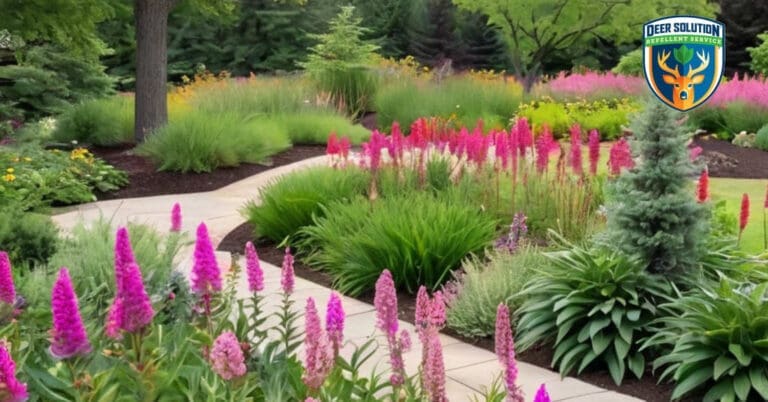With their signature silvery leaves and velvety texture, Dusty Millers are a stunning addition to any garden. Their shimmering foliage makes them an ideal choice for borders, containers, and mixed flower beds. But for gardeners in deer-prone areas, the question arises: are these striking plants safe from browsing deer? Fortunately, perennial Dusty Millers (Senecio cineraria) are known for their deer-resistant qualities, combining beauty and resilience for worry-free gardening.
Why Dusty Millers Stand Out in the Garden
Dusty Millers are celebrated for their silvery-gray, lobed leaves, which are covered in fine, velvety hairs. This unique texture not only creates a luminous visual effect but also serves a practical purpose by helping the plant retain moisture in hot, dry conditions. Thriving in full sun and well-drained soils, Dusty Millers are drought-tolerant and highly adaptable, making them an excellent choice for low-maintenance landscapes.
These versatile perennials add a striking contrast to gardens, complementing vibrant flowers with their muted tones. Whether used as a border plant, an accent in mixed beds, or in container arrangements, Dusty Millers provide year-round visual interest in warmer climates where they can survive as perennials.
How Do Dusty Millers Compare to Other Deer-Resistant Plants?
Dusty Millers are rarely a target for deer due to their fuzzy texture and slightly bitter taste, which make them less palatable compared to softer, more flavorful plants. The fine hairs on their leaves act as a natural deterrent, and their lack of strong fragrance further reduces their appeal. Compared to other deer-resistant plants like lavender and yarrow, Dusty Millers stand out for their unique silver tones and adaptability to harsh environments.
Even in areas with high deer populations, Dusty Millers are often bypassed, making them a reliable choice for maintaining a beautiful, low-maintenance garden. In gardens with extreme deer pressure, pairing them with other resistant plants like salvia or rosemary can further reduce browsing risks.
Seasonal and Regional Insights for Dusty Millers
Understanding how seasonal changes and regional conditions impact Dusty Millers can help gardeners maximize their success. In spring, when tender new growth appears, they may be slightly more vulnerable to deer nibbling. Regularly monitoring growth during this time and pairing Dusty Millers with aromatic plants can provide added protection.
Regionally, Dusty Millers thrive in arid or semi-arid climates where their drought tolerance shines. In wetter regions, ensuring proper drainage is crucial to prevent root rot. Their ability to stabilize soil makes them particularly effective on slopes or windy areas, reducing erosion while adding beauty to challenging landscapes.
Creative Design Ideas with Dusty Millers
The unique color and texture of Dusty Millers make them an excellent addition to a variety of garden designs. Here are a few creative ways to use them:
- Moonlight Gardens: Their silvery foliage reflects light beautifully, making them ideal for evening or moonlight gardens. Pair them with white blooms like alyssum or petunias to create a serene, glowing landscape.
- Mediterranean Themes: Combine Dusty Millers with other drought-tolerant plants like rosemary, salvia, and sedum for a cohesive, low-water garden inspired by Mediterranean landscapes.
- Contrast Planting: Use Dusty Millers as a backdrop for vibrant annuals like zinnias, marigolds, or geraniums. Their muted tones enhance the brightness of colorful flowers, creating eye-catching displays.
Sustainable Gardening Practices for Dusty Millers
Dusty Millers are not only beautiful but also contribute to sustainable gardening. Here’s how to make the most of their natural resilience:
- Drought Tolerance: Once established, Dusty Millers require minimal watering, making them ideal for xeriscaping or water-wise gardens. Their ability to thrive in dry soils reduces the need for irrigation, conserving water resources.
- Soil Stabilization: Plant Dusty Millers on slopes or windy areas where their root systems can help prevent soil erosion and maintain stability.
- Low Maintenance: These perennials require little upkeep, thriving without frequent fertilization or pest control. Their ability to self-sustain makes them an excellent choice for gardeners seeking long-term beauty with minimal effort.
Resilient Beauty with Expert Support
For gardeners in areas with persistent deer activity, Dusty Millers offer an elegant and resilient option. While their natural resistance often keeps deer at bay, professional services can provide added peace of mind. Deer Solution specializes in eco-friendly strategies tailored to protect plants like Dusty Millers, enhancing their resilience against browsing. By blending expertise with sustainable practices, Deer Solution ensures that your garden remains a thriving sanctuary year-round.








